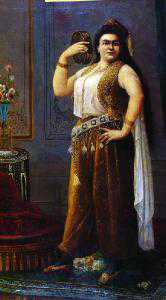ISTANBUL – Daily News with wires

The Greek Painters of Istanbul at the Topkapı Palace, a new exhibition at the famous Istanbul landmark, is bringing to light close to 100 works by Greek painters from the city. Although the native-born artists contributed greatly to culture in the late Ottoman era, there is little information on them in either the Ottoman or present-day sources
Istanbul’s Topkapı Palace is hosting a new exhibition featuring 100 pieces of art by Istanbul Greek painters who were influential in the late Ottoman artistic world.
“People from different faith groups have created very important works on Anatolian land. It is our mission to exhibit these works to the current generations,” Turkish Culture Minister Ertuğrul Günay, who is helping to organize the Greek Painters of Istanbul at Topkapı Palace show, said Monday during the show’s opening ceremony.
Günay also said his ministry had established very close relations with the leaders of various faith groups and that the exhibition was one of the results of those relations.
The works of the Greek painters are a part of Turkish culture, said Fener Greek Patriarch Bartholomew, who attended the show’s opening ceremony Monday. “We, as the Greek community and the Greek Patriarchate, are a part of this country, too.”
The exhibition, which is based on the book “Istanbullu Rum Ressamlar” (Greek Painters of Istanbul” by Mayda Sari, who is also the curator of the exhibition, features Greek painters who were born or raised in Istanbul. It brings together selected works from Greek Orthodox churches and private collections, as well as the collections of the Topkapı Palace, the Greek Orthodox Patriarchate and the Halki Theological School.
The minister also expressed his objection to the translation of the term “Rum,” which is used in Turkish to refer to the Greek Orthodox Christians living in Anatolia but often rendered simply as “Greek” in English, providing no differentiation between the group and the Greeks from Greece proper.
“‘Rum’ is the name of the [Greek Orthodox Christian] Anatolian population who lived on Ottoman lands. It is a part of Turkish culture, not a separate population,” Günay said.
The exhibition brings to light the works of painters who contributed greatly to Ottoman culture but on whom little can be found in Ottoman and present-day sources. Visitors will have the chance to see works by 19th- and early-20th-century painters and iconographers, such as Armenopoulos, Andreades, Andoniades, Flora-Karavia, İgum (Igoumenides), Economides, Xanthopoulos, Michelidakes, Petridou, Platonides, Savvides, Scarlatos, Sofroniades, Stavrakes, Vakalopoulos, as well as Konstantinos Kyzikinos (Kapıdağlı Konstantin).
Divided along thematic and chronological lines, the exhibition is comprised of approximately 100 works and includes portraits of sultans and high-ranking Ottoman officials, portraits of high-ranking clergy from the collection of the Halki Theological School, icons selected from churches, as well as views of Istanbul.
The event is being organized by the Directorate of the Topkapı Palace Museum and the Consulate General of Greece in Istanbul under the auspices of Günay’s ministry.
The exhibition will continue at the Topkapı Palace Museum Imperial Stables until June 30.
via Topkapı Palace welcomes works from Istanbul Greek painters – Hurriyet Daily News and Economic Review.

Leave a Reply